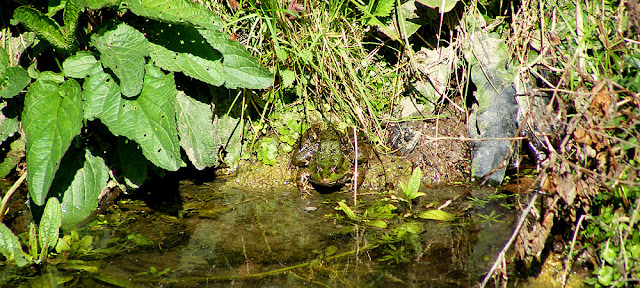My friend Marie-Claude Derrien led an outing to the Moulin de Malicorne in the Courtineau Valley, between Sainte Maure de Touraine and Saint Epain on 23 March 2019. The Moulin ('mill') is the home of science journalist Declan, who works for Nature, and Gaëlle, a science editor for various scholarly journals. He is Northern Irish, she comes from a local family. They live there with their children and their Golden Retriever, Hacker. They manage the site, which is crossed by the Courtineau River and various mill ponds and streams, with wildlife in mind. It is a paradise for kids (although Declan has some stories about preventing them and their friends from drowning when they were small). The day of our visit coincided with the big anti-Brexit march in London, and Declan shared news of it with me on his IPhone. He took out French citizenship a couple of years ago, but still finds himself glued to the news about Brexit.
There are
530 species of lichen in Indre et Loire. Lichens are not seasonal, so you can go hunting for them at any time. Lichens are complex organisms made up of algae, cyanobacteria and fungi working together symbiotically. The genus name of a lichen is for the fungus, the species name is a descriptor of form or colour, for example.
An exceptional troglodyte home just down the road from the Moulin de Malicorne, at Souvres.
Marie-Claude Derrien checking out a lichen on a low stone wall.
Swings and rings on a tree in the garden.
Lichen enthusiasts and residents of the Courtineau Valley who want to learn about their environment gather at the start of the outing.
Garden and millstream filtered by Weeping Willow spring growth.
The lichen Blennothallia crispa on a limestone wall. This one is rather dried out as it was a hot day. Normally it is rather gelatinous, and the species likes damp shade.
Rare breed Touraine geese wander freely around the millponds.
Boys messing about in a boat on the millpond.
Edible Frog Pelophylax kl. esculentus (Fr. Grenouille verte), part of the green frog group. It's in no danger of being eaten though. The species is protected in France, and anyway, almost no one eats frogs legs...
The lichen Caloplaca chrysodeta, on the limestone cliff behind the mill, a typical location for this species.
Part II is here.
************************************************
For details of our private guided tours of chateaux, gardens, wineries, markets and more please visit the Loire Valley Time Travel website. We would be delighted to design a tour for you.
We are also on Instagram, so check us out to see a regularly updated selection of our very best photos.
We are also on Instagram, so check us out to see a regularly updated selection of our very best photos.











4 comments:
Late in the day comment. That photo of the springtime willows by the mill pond is enchanting...lucky children growing up in such a place.
Google provides interesting information on how to "transplant" a lichen from one place to another.
I couldn't get the Part ll link to work.
There is a very interesting and seemingly very complete entry in Wikipedia about the use of the hyphen in France and in francophonie.
The Part II link doesn't work because I haven't got round to doing the html, sorry
Yes, I understand your issues with hyphenation, but am just going to continue being lazy. Hyphenation is dying out.
Post a Comment